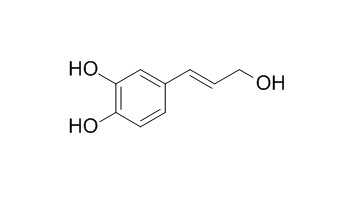Caffeoyl alcohol
Reference standards.
Inquire / Order:
manager@chemfaces.com
Technical Inquiries:
service@chemfaces.com
Tel:
+86-27-84237783
Fax:
+86-27-84254680
Address:
1 Building, No. 83, CheCheng Rd., Wuhan Economic and Technological Development Zone, Wuhan, Hubei 430056, PRC
Providing storage is as stated on the product vial and the vial is kept tightly sealed, the product can be stored for up to
24 months(2-8C).
Wherever possible, you should prepare and use solutions on the same day. However, if you need to make up stock solutions in advance, we recommend that you store the solution as aliquots in tightly sealed vials at -20C. Generally, these will be useable for up to two weeks. Before use, and prior to opening the vial we recommend that you allow your product to equilibrate to room temperature for at least 1 hour.
Need more advice on solubility, usage and handling? Please email to: service@chemfaces.com
The packaging of the product may have turned upside down during transportation, resulting in the natural compounds adhering to the neck or cap of the vial. take the vial out of its packaging and gently shake to let the compounds fall to the bottom of the vial. for liquid products, centrifuge at 200-500 RPM to gather the liquid at the bottom of the vial. try to avoid loss or contamination during handling.
Separations2023, 10(11), 567;
Plant Methods.2017, 13:108
Sci Rep.2021, 11(1):14180.
Front Aging Neurosci.2018, 10:269
Biomolecules2021, 11(10),1513.
J Biochem Mol Toxicol.2022, e23211.
Chung Shan Medical University2020, US20200323790A1
Sci Rep.2018, 8(1):12970
Pharmaceuticals (Basel).2021, 14(6):588.
Front Pharmacol.2022, 13:870553.
Related and Featured Products
Plant Journal, 2001, 25.
Substrate preferences of O‐methyltransferases in alfalfa suggest new pathways for 3‐O‐methylation of monolignols.[Reference:
WebLink]
METHODS AND RESULTS:
Measurement of relative O‐methyltransferase activities against all potential substrates in the monolignol pathway in developing alfalfa stem extracts revealed activities in the order: caffeoyl CoA > Caffeoyl alcohol > 5‐hydroxyferulic acid > caffeoyl aldehyde > 5‐hydroxyconiferyl alcohol > 5‐hydroxyferuloyl CoA > 5‐hydroxyconiferaldehyde > caffeic acid. Maxima for all activities occurred in the seventh internode. In stem extracts from transgenic alfalfa with antisense downregulated caffeoyl CoA O‐methyltransferase (CCoAOMT), activities with all substrates except for the two coenzyme A esters were unaffected. In contrast, downregulation of caffeic acid O‐methyltransferase (COMT) reduced activities against the non‐esterifed substrates in the order: 5‐hydroxyconiferyl alcohol > 5‐hydroxyferulic acid and Caffeoyl alcohol > caffeoyl aldehyde > caffeic acid > 5‐hydroxyconiferaldehyde. Recombinant COMT expressed in Escherichia coli exhibited the highest Vmax/Km values with 5‐hydroxyconiferaldehyde and caffeoyl aldehyde, and the lowest with caffeic acid.
CONCLUSIONS:
These results indicate that COMT is unlikely to methylate caffeic acid during lignin biosynthesis in vivo, and provide enzymatic evidence for an alternative pathway to monolignols involving methylation of caffeoyl aldehyde and/or Caffeoyl alcohol by COMT. The concept of independent pathways to guaiacyl and syringyl monolignols is discussed.



